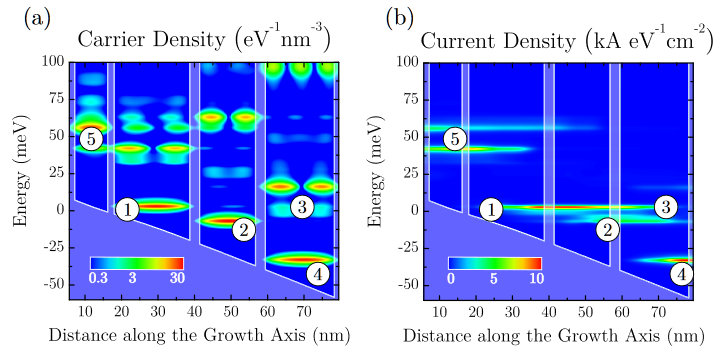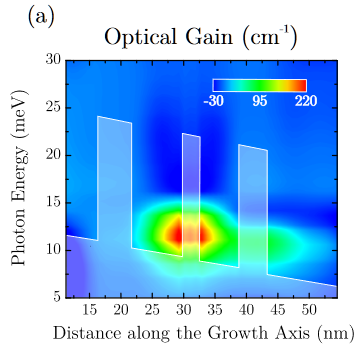4.1. Overview
This documentation describes nextnano.MSB, an NEGF quantum transport code based on the MSB method.
The nextnano.MSB tool has been developed to simulate Quantum Cascade Lasers (QCLs) and Resonant Tunneling Diodes (RTDs). The tool calculates current-voltage characteristics and gain.

Figure 4.1.1 Calculated electron and current density of a Quantum Cascade Laser
This tool is based on a novel quantum transport method that follows the non-equilibrium Green’s function (NEGF) framework but sidesteps any self-consistent calculation of lesser self-energies by replacing them by a quasi-equilibrium expression. This method generalizes the so-called Büttiker probe model but takes into account all relevant individual scattering mechanisms. It is orders of magnitude more efficient than a fully self-consistent NEGF calculation for realistic devices, yet accurately reproduces the results of the latter method. This method opens the path towards realistic three-dimensional quantum transport calculations.
MSB is the acronym of the Multi-Scattering Büttiker probe model.
The nextnanomat GUI can execute the code and visualize the results.

Figure 4.1.2 Calculated gain of a Quantum Cascade Laser
Which scattering mechanisms are included?
Longitudinal polar-optical phonon scattering (polar LO phonon scattering).
Acoustic phonon scattering which includes some kind of interface roughness scattering. The latter is intrinsically included.
Where can I find some background on the implemented physics?
The MSB method is described in the following publications: [GreckOE2015], [GreckIWCE2010], [GreckPhD2012]
Copyright information
The nextnano.MSB tool has been developed by Dr. Peter Greck for the nextnano GmbH. It is written in C++.